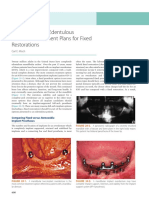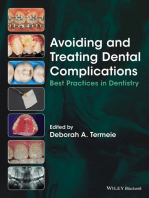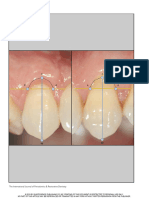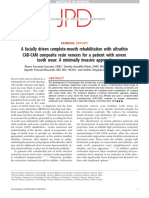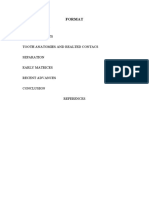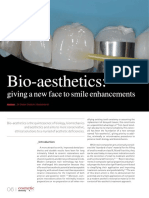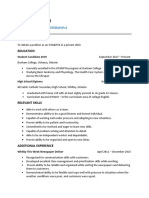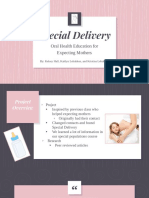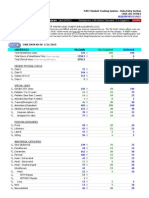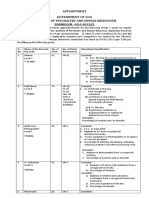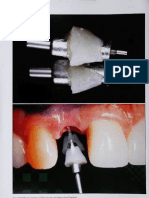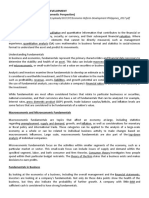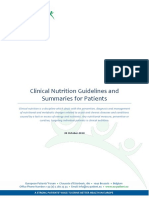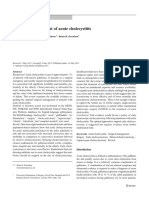Socket Classification Article
Socket Classification Article
Uploaded by
Berkshire District Dental SocietyCopyright:
Available Formats
Socket Classification Article
Socket Classification Article
Uploaded by
Berkshire District Dental SocietyOriginal Description:
Copyright
Available Formats
Share this document
Did you find this document useful?
Is this content inappropriate?
Copyright:
Available Formats
Socket Classification Article
Socket Classification Article
Uploaded by
Berkshire District Dental SocietyCopyright:
Available Formats
C O N T I N U I N G
E D U C A T I O N
A SIMPLIFIED SOCKET CLASSIFICATION AND R EPAIR T ECHNIQUE
Nicolas Elian, DDS* Sang-Choon Cho, DDS, MS Stuart Froum, DDS Richard B. Smith, DDS Dennis P. Tarnow, DDS||
19 2
Clinicians are often confronted with changes in the anatomy of the local site following tooth extraction. Successful management of the extraction socket can be challenging, particularly in the aesthetic zone. Proper management is necessary to ensure that the implant used to support a prosthesis will remain stable. This article will recommend a classification system for various types of extraction sockets. A simple, noninvasive approach to the grafting and management of sockets when soft tissue is present but the buccal plate is compromised following tooth extraction will also be discussed.
Learning Objectives: This article discusses a classification system for extraction sockets and a noninvasive approach for grafting. Upon reading this article, the reader should: Understand the proposed classification system, which addresses three different types of sockets. Become more familiar with the steps involved in a socket-repair technique for Type II sockets.
Key Words: extraction socket, buccal plate, Type II socket, noninvasive
* Associate Professor, Division Head of Department of Implant Dentistry, Department of Periodontology and Implant Dentistry, New York University College of Dentistry, New York, NY; private practice, Fort Lee, NJ. Clinical Assistant Professor, Department of Periodontology and Implant Dentistry, New York University College of Dentistry, New York, NY; private practice, New York, NY. Clinical Professor, Department of Periodontology and Implant Dentistry, New York University College of Dentistry, New York, NY; private practice, New York, NY. Fellow, Department of Periodontology and Implant Dentistry, New York University College of Dentistry, New York, NY; private practice, New York, NY. | |Professor and Chair, Department of Periodontology and Implant Dentistry, New York University College of Dentistry, New York, NY; Section Editor, Periodontology/Implantology, PPAD; private practice, New York, NY. Nicolas Elian, DDS, 345 E. 24th Street, New York, NY 10010 Tel: 212-998-9421 E-mail: ne3@nyu.edu
Pract Proced Aesthet Dent 2007;19(2):99-104
99
MARCH
ELIAN
Practical Procedures & AESTHETIC DENTISTRY
functional, highly aesthetic implant restoration has become the goal of therapy for both patients and clinicians, which coincides with the greater demand for quicker and less invasive implant procedures. The first step in the transition from a failing tooth to an implantsupported prosthesis is the extraction of the tooth and management of the extraction socket. Various treatment options have been proposed, including extraction with or without socket preservation surgery, immediate implant placement, and delayed implant placement with or without ridge augmentation. Multiple techniques have been used to treat extraction sockets. These techniques range from using full flaps to no flaps to utilizing different types of grafts (if any), bone replacement materials, and membranes (eg, absorbable, nonabsorbable).1-13 One of the primary factors determining which treatment to select in the aesthetic zone is the presence and degree of soft tissue recession on the tooth being extracted, and the presence or absence of the buccal plate of bone. Several publications have based treatment recommendation of the socket (ie, immediate or delayed implant placement), with or without augmentation procedures, on the socket morphology following tooth extraction.14,15 This article presents both a new, simple classification of extraction sockets and an easy noninvasive approach to the grafting of sockets when soft tissue is present but the buccal plate is partially or totally missing after extraction.
Figure 2. Diagram of a tooth that is diagnosed as hopeless due to incisal trauma.
Figure 3. Once the tooth is atraumatically removed, a collagen membrane is contoured into a modified V-shape to fit inside the extraction socket.
Classification of Extraction Sockets
There have been a number of proposed systems to classify extraction sockets.14 Some of these are very detailed and intricate for routine clinical use. Following years of
Figure 4. The membrane is positioned in the socket lining the buccal tissues, and graft material is placed.
Type I
Type II
Type III
Figure 1. Illustration of the three types of extraction sockets, as defined by the facial soft tissue and buccal plate of bone present.
socket research and analysis, it has become obvious to the authors that although there are multiple variables present with every extraction socket, the key factor determining the quality of the socket following extraction is the presence or absence of the buccal hard and soft tissue. Therefore, a new simplified classification will be proposed. This classification should allow easier documentation and better communication between clinicians, researchers, and authors. The classification is divided in to three socket types.
100
Vol. 19, No. 2
Elian
Figure 5. The membrane is sutured utilizing absorbable sutures to the palatal tissue.
Figure 6. The buccal tissue is prevented from migrating into the healing socket.
Type I sockets are the easiest and most predictable to treat. Most of the cases seen demonstrating excellent aesthetics with implants are Type I sockets. This is particularly true if the soft tissue profile is thick and flat as opposed to a highly scalloped, thin profile.16 Type III sockets, however, are very difficult to treat and require soft tissue augmentation with additional grafts of connective tissue, or connective tissue and bone, in a staged approach to rebuild lost tissue. These cases are associated with soft tissue recession and loss of the buccal plate on the tooth prior to extraction. Sockets in this classification require very high dental experience, skill, and time commitment for success. Type II sockets are oftentimes the most difficult to diagnose. These sockets can be very deceptive, as the inexperienced clinician may make the mistake of treating it as a Type I socket. This often leads to a less than ideal aesthetic result. The largest group of aesthetic problems comes from improper treatment of Type II sockets because of the posttreatment soft tissue recession that may occur. This is particularly true when immediate implant placement is performed. Many different procedures have been suggested to treat sockets of this type.17-19 This article will present a treatment for Type II sockets that should be easier, less complicated, and equally predictable compared to more difficult techniques.20
Rationale for New Socket Repair Technique
The ideal technique for restoring the buccal plate of bone after tooth extraction should be simple, minimally invasive, and preserve the attached gingiva and soft tissue contours. Moreover, this should be achieved with minimal surgery.
Figure 7. Patient presented with pain and mobility of tooth #8(11), which was diagnosed as hopeless due to horizontal and vertical root fractures.
Type I Socket. The facial soft tissue and buccal plate of bone are at normal levels in relation to the cementoenamel junction of the pre-extracted tooth and remain intact postextraction (Figure 1). Type II Socket. Facial soft tissue is present but the buccal plate is partially missing following extraction of the tooth. Type III Socket. The facial soft tissue and the buccal plate of bone are both markedly reduced after tooth extraction.
Figure 8. The defect was classified as Type II. Tissue was present on the facial but not the buccal plate.
PPAD
101
Practical Procedures & AESTHETIC DENTISTRY
for this technique is a small-particle, mineralized cancellous freeze-dried bone allograft (ie, 0.25 mm to 1 mm). This graft material should be hydrated for five minutes and retain enough moisture for the particles to aggregate when inserted. This allograft material compresses well and, because it is mineralized, slowly resorbs. It also helps keep the shape of the socket while new bone repopulates and fills the socket during healing. Step 5. After the graft is compressed, the top part of the membrane is extended over the opening of the socket. The membrane is then sutured with two or three
Figure 9A. The trimmed Socket Repair Membrane (Zimmer Dental, Carlsbad, CA) was adapted in the socket. 9B. The pre-cut membrane should extend over the facial defect both bilaterally and apically.
The socket repair technique proposed in this article is intended for Type II sockets, where a significant amount of the buccal plate is missing following extraction. Step 1. Once the tooth is diagnosed as hopeless (Figure 2), it is removed atraumatically. This should be performed utilizing flapless extraction with care not to disturb the interproximal papillae and labial soft tissue. Step 2. The socket is then debrided with surgical curettes, and any infected tissue is removed. A finger should be placed over the buccal tissue when curetting the buccal part of the socket to prevent perforation of the soft tissue. Step 3. A collagen membrane is contoured into a modified V-shape (Figure 3). The membrane should be strong so that it can be sutured and maintain a long absorption time to allow for guided bone regeneration. The membrane must also be firm enough to allow insertion into the socket without collapsing. The barrier used with this technique is an absorbable collagen membrane that can be sutured without tearing. The narrow part of the trimmed membrane (ie, a V-shaped cone) is placed into the socket and should be wide enough to extend laterally past the defect in the buccal wall. Placing the membrane on the external aspect of the buccal wall could compromise its blood supply and cause an increased chance of resorption. The wider part of the membrane should be trimmed and be able to cover the opening of the socket following graft placement. Step 4. Following final shaping, the membrane is positioned into the socket lining the buccal tissues. The socket is then filled with a bone graft; pressure from the graft against the membrane will help keep it in place and push out the contour of the buccal tissue (Figure 4). Ideally, the graft material should be compressed into the socket and remain in place. The graft material recommended
Figure 10. Compressed small particle graft (ie, Puros, Zimmer Dental, Carlsbad, CA) in place within the socket.
Figure 11. Once the graft material was placed, the soft tissue was sutured palatally with 5-0 absorbable sutures.
Figure 12. A removable flipper was placed with no pressure on the membrane.
102
Vol. 19, No. 2
Elian
5-0 absorbable sutures to the palatal tissue (Figure 5). No sutures are needed on the buccal aspect since the membrane is kept in place from the pressure of the graft against the buccal tissue.
Discussion
This minimally invasive technique satisfies the critical requirements needed for socket repair. By not reflecting or coronally advancing the buccal flap, there is no change in the mucogingival junction (MGJ) position. This is
Figure 16. Postoperative view of the definitive implant-supported crown restoration demonstrates natural aesthetics and integration.
Figure 13. Facial view of the socket two weeks following tooth extraction.
Figure 14. Radiograph of the socket site two months postextraction.
Figure 15. Facial view of the treatment site six months following extraction.
particularly important in the aesthetic zone, where coronal advancement of the MGJ often requires subsequent apical repositioning with additional surgery following socket healing to re-establish a band of keratinized tissue on the buccal aspect of the implant and ideal MGJ. In considering use of the membrane in this technique, it is important for the practitioner to understand how the objectives of guided bone regeneration and socket preservation differ. In the former, the goal is formation of new bone. In socket preservation, however, the goal is to maintain both hard and soft tissue levels. The purpose of the membrane is to contain the graft, which in turn prevents invasion of soft tissue into the socket. By placing the membrane inside the socket, the periosteum is not detached from the remaining buccal plate, which will occur if a flap is reflected exposing the buccal plate. The clinician is still able to push the buccal tissues facially by compressing the graft properly. Therefore, the buccal tissue contours are not compromised. Moreover, placing the membrane inside the socket before the graft is placed results in particle containment and maintains the soft tissue morphology. The buccal tissue is prevented from migrating into the healing socket and, therefore, bone cells from the socket walls can now repopulate the defect forming new bone (Figure 6). Placement of the membrane in the socket covers a portion of the buccal wall. This allows the other three walls to contribute to the repopulation of the socket and healing of the graft. The absorbable membrane will block the overlying soft tissue from repopulating the defect. It will then resorb over a period of four months, preventing soft tissue from the buccal aspect (in the area of the defect) from penetrating into the graft material. The coronal part of the membrane that is left exposed will start to resorb over the course of the first
PPAD
103
Practical Procedures & AESTHETIC DENTISTRY
two weeks after placement. This membrane serves as a graft containment and as protection for the initial clot. Some coronal particles of the graft occasionally migrate out of the socket, but the remaining part of the graft and the membrane that is covered by the buccal tissue will still be available to form new bone in the socket. Timing of implant placement should be determined by the size of the buccal wall defect; the larger the defect, the more time that is needed. The minimum time needed is usually four to six months for the bone to fill in. The classification presented in this article allows the clinicians to determine if socket surgery is necessary and whether an immediate or delayed implant protocol is indicated. Previous classifications focused on socket parameters that would allow immediate implant placement as opposed to the approach indicating augmentation of the defect following extraction and healing.2-5 The current classification is simple because it easily identifies the socket type and this determines which treatment should be followed (Figures 7 through 16). Type I sockets require no augmentation and can be treated with an immediate or delayed implant approach. Type II and III sockets require socket treatment and should be treated with a staged approach since, following socket healing, additional soft and hard tissue surgery may be necessary prior to implant placement. This allows site preparation to be completed prior to implant placement, which will then produce the best aesthetics possible. This classification also has a biological basis in that the vascular supply to the buccal plate of bone is considered in the overall healing response. This is aimed at maintenance of the buccal plate of bone, which is the essential parameter in determining mid-buccal recession following implant placement. This should increase the predictability of a highly aesthetic final result.
Acknowledgment
The authors declare no financial interest in any of the products referenced herein.
References
1. Gelb DA. Immediate implant surgery: 3-year retrospective evaluation of 50 consecutive cases. Int J Oral Maxillofac Impl 1993;8:388-399. 2. Garber DA. Belser UC. Restoration-driven implant placement with restoration-generated site development. Compend Cont Educ Dent 1995;16(8):796-804. 3. Salama H. Salama M. The role of orthodontic extrusive remodeling in the enhancement of soft and hard tissue profiles prior to implant placement: A systematic approach to the management of extraction site defects. Int J Perio Rest Dent 1993;13(4):312-333. 4. Meltzer AM. Non-resorbable-membrane-assisted bone regeneration: Stabilization and the avoidance of micromovement. Dent Impl Update 1995;6(6):45-48. 5. Tinti C, Parma-Benfenati S. Clinical classification of bone defects concerning the placement of dental implants. Int J Perio Rest Dent 2003;23(2):147-155. 6. Sclar AG. The Bio-Col Technique. In: Soft Tissue and Esthetic Considerations in Implant Therapy. Carol Stream, IL: Quintessence Publishing Co; 2003:75-112. 7. Landsberg CJ. Socket seal surgery combined with immediate implant placement: A novel approach for single-tooth replacement. Int J Perio Rest Dent 1997;17(2):140-149. 8. Garber DA, Salama MA, Salama H. Immediate total tooth replacement. Compend Contin Educ Dent 2001;22(3):210-218. 9. Becker W, Dahlin C, Becker BE, et al. The use of e-PTFE barrier membranes for bone promotion around titanium implants placed into extraction sockets: A prospective multicenter study. Int J Oral Maxillofac Impl 1994;9(1):31-40. 10. Boyne PJ. Use of HTR in tooth extraction sockets to maintain alveolar ridge height and increase concentration of alveolar bone matrix. Gen Dent 1995;43(5):470-473. 11. Brugnami F, Then PR, Moroi H, et al. GBR in human extraction sockets and ridge defects prior to implant placement: Clinical results and histologic evidence of osteoblastic and osteoclastic activities in DFDBA. Int J Perio Rest Dent 1999;19(3):259-267. 12. Carmagnola D, Adriaens P, Berglundh T. Healing of human extraction sockets filled with Bio-Oss. Clin Oral Implants Res 2003;14(2):137-143. 13. Lekovic V, Camargo P, Klokkevold P, et al. Preservation of alveolar bone in extraction sockets using bioabsorbable membranes. J Periodont 1998;69(9):1044-1049. 14. Saadoun AP, Landsberg CJ. Treatment classifications and sequencing for postextraction implant therapy: A review. Pract Periodont Aesthet Dent 1997;9(8):933-941. 15. Schropp L, Kostopoulos L, Wenzel A. Bone healing following immediate versus delayed placement of titanium implants into extraction sockets: A prospective clinical study. Int J Oral Maxillofac Impl 2003;18(2):189-199. 16. Kan JY, Rungcharassaeng K, Umezu K, Kois JC. Dimensions of peri-implant mucosa: An evaluation of maxillary anterior single implants in humans. J Periodont 2003;74(4):557-562. 17. Becker W, Dahlin C, Becker BE, et al. The use of e-PTFE barrier membranes for bone promotion around titanium implants placed into extraction sockets: A prospective multicenter study. Int J Oral Maxillofac Impl 1994;9(1):31-40. 18. Becker W, Becker B, Polizzi G, Bergstrom C. Autogenous bone grafting of bone defects adjacent to implants placed into immediate extraction sockets in patients: A prospective study. Int J Oral Maxillofac Impl 1994;9:389-396. 19. Warrer L, Gotfredsen K, Hjorting-Hansen E, Karring T. Guided tissue regeneration ensures osseointegration of dental implants placed into extraction sockets. An experimental study in monkeys. Clin Oral Implants Res 1991;2(4):166-171. 20. Butler B. Utilizing microsurgical techniques for augmenting the extraction socket. Presented at the 87th meeting of the American Academy of Periodontology, October 6-10, 2001, Philadelphia, PA.
Conclusion
A new and simplified socket classification and treatment have been presented. This classification is simple, based on the presence or absence of buccal hard and soft tissue following tooth extraction, and is valuable clinically as a method of determining socket treatment options and timing of implant placement. This minimally invasive socket repair technique has the advantage of being flapless, not distorting the buccal and interproximal tissue contours, preserving the height of the MGJ, and allowing for the reformation of the buccal plate of bone. Thus, comparison of bone levels prior to and following treatment should be a goal of future studies with this technique. Nevertheless, the technique is not complicated and may be easily used in combination with the extraction of any tooth.
104
Vol. 19, No. 2
CONTINUING EDUCATION (CE) EXERCISE NO. 4
please refer to the CE Editorial Section.
CE
4
CONTINUING EDUCATION
To submit your CE Exercise answers, please use the answer sheet found within the CE Editorial Section of this issue and complete as follows: 1) Identify the article; 2) Place an X in the appropriate box for each question of each exercise; 3) Clip answer sheet from the page and mail it to the CE Department at Montage Media Corporation. For further instructions,
The 10 multiple-choice questions for this Continuing Education (CE) exercise are based on the article A simplified socket classification and repair technique, by Nicolas Elian, DDS, Sang-Choon Cho, DDS, MS, Stuart Froum, DDS, Richard B. Smith, DDS, and Dennis P. Tarnow, DDS. This article is on Pages 99-104.
1. What is the first step in the transition from a failing tooth to an implant-supported prosthesis? a. The extraction of the tooth. b. The management of the extraction socket. c. Neither a nor b. d. Both a and b. 2. Type III sockets are very difficult to treat and often require which of the following? a. A very high degree of dental experience. b. Skill. c. Time commitment for success. d. All of the above. 3. What makes up the ideal technique for restoring the buccal plate of bone after tooth extraction? a. It should be simple. b. It should be minimally invasive. c. It should preserve the attached gingiva and soft tissue contours. d. All of the above. 4. What is done to the socket in Step 2 of the New Socket Repair Technique? a. The socket is debrided with surgical curettes. b. The tooth is removed atraumatically. c. A collagen membrane is contoured into a modified V-shape. d. None of the above. 5. What classifies a socket as a Type III Socket? a. The facial soft tissue is present and not reduced after extraction. b. The facial soft tissue and buccal plate are reduced after extraction. c. The buccal plate is partially missing following extraction of the tooth. d. The facial soft tissue and buccal plate are at normal levels.
6. After the graft is compressed, which part of the membrane is extended over the opening of the socket? a. The bottom of the membrane. b. The side of the membrane. c. The top of the membrane. d. No part of the membrane is extended over the socket. 7. A collagen membrane is contoured into what modified shape? a. A modified U-shape. b. A modified V-shape. c. A modified O-shape. d. A modified C-shape. 8. The goal of guided bone regeneration is the formation of new bone. The goal of socket preservation is to maintain both hard and soft tissue levels. a. The first statement is true. b. The second statement is true. c. Both statements are true. d. Neither statement is true. 9. How many weeks after placement will the coronal part of the membrane that is left exposed start to resorb? a. Two weeks. b. Five weeks. c. Seven weeks. d. Four weeks. 10. Timing of implant placement should be determined by the size of the buccal wall defect. The smaller the defect, the more time that is needed. a. The first statement is true. b. The second statement is true. c. Neither statement is true. d. Both statements are true.
106
Vol. 19, No. 2
You might also like
- Fertility Activation ChecklistDocument5 pagesFertility Activation Checklistvotenib862No ratings yet
- Treatment Planning of Teeth With Compromised Clinical Crowns Endodontic, Reconstructive, and Surgical StrategyDocument20 pagesTreatment Planning of Teeth With Compromised Clinical Crowns Endodontic, Reconstructive, and Surgical Strategyfloressam2000No ratings yet
- 32-282 Medical Surveillance ProcedureDocument28 pages32-282 Medical Surveillance ProcedureMatshilario60% (5)
- Ensuring Patient Comfort and Clinical Accuracy During Impression Taking 3Document11 pagesEnsuring Patient Comfort and Clinical Accuracy During Impression Taking 3Raul HernandezNo ratings yet
- The Osteoperiosteal Flap: A Simplified Approach to Alveolar Bone ReconstructionFrom EverandThe Osteoperiosteal Flap: A Simplified Approach to Alveolar Bone ReconstructionRating: 4 out of 5 stars4/5 (1)
- The Completely Edentulous Mandible: Treatment Plans For Fixed RestorationsDocument15 pagesThe Completely Edentulous Mandible: Treatment Plans For Fixed Restorationswaf51No ratings yet
- Dental Implant Treatment Planning for New Dentists Starting Implant TherapyFrom EverandDental Implant Treatment Planning for New Dentists Starting Implant TherapyRating: 4 out of 5 stars4/5 (1)
- (2019) Cervical Margin Relocation - Case Series and New Classification Systems. CHECKDocument13 pages(2019) Cervical Margin Relocation - Case Series and New Classification Systems. CHECKBárbara Meza Lewis100% (2)
- Immediate Dental Implant Placement Into Infected vs. Non-Infected Sockets: A Meta-AnalysisDocument7 pagesImmediate Dental Implant Placement Into Infected vs. Non-Infected Sockets: A Meta-Analysismarlene tamayoNo ratings yet
- Inlay Onlay Parte 222 PDFDocument23 pagesInlay Onlay Parte 222 PDFKhenny Jhynmir Paucar VillegasNo ratings yet
- (IJPRD) GLUCKMAN 2017 - Partial Extraction Therapies Part 2 PDFDocument11 pages(IJPRD) GLUCKMAN 2017 - Partial Extraction Therapies Part 2 PDFFelipeGuzanskyMilaneziNo ratings yet
- Injection Overmolding For Aesthetics and Strength Part 1Document4 pagesInjection Overmolding For Aesthetics and Strength Part 1The Bioclear Clinic100% (1)
- IJEDe 15 01 Part-IDocument18 pagesIJEDe 15 01 Part-IDanny Eduardo Romero100% (1)
- Qip ProjectDocument14 pagesQip Projectapi-490662977No ratings yet
- Treatment Planning Single Maxillary Anterior Implants for DentistsFrom EverandTreatment Planning Single Maxillary Anterior Implants for DentistsNo ratings yet
- Avoiding and Treating Dental Complications: Best Practices in DentistryFrom EverandAvoiding and Treating Dental Complications: Best Practices in DentistryDeborah A. TermeieNo ratings yet
- Minimally Invasive Periodontal Therapy: Clinical Techniques and Visualization TechnologyFrom EverandMinimally Invasive Periodontal Therapy: Clinical Techniques and Visualization TechnologyNo ratings yet
- Fundamentals of Oral and Maxillofacial RadiologyFrom EverandFundamentals of Oral and Maxillofacial RadiologyRating: 4 out of 5 stars4/5 (1)
- Advance in MaterialsDocument10 pagesAdvance in Materialssami robalinoNo ratings yet
- Immediate Implant Placement PDFDocument11 pagesImmediate Implant Placement PDFFerdinan PasaribuNo ratings yet
- Naturally Aesthetic Restorations and Minimally Invasive DentistryDocument12 pagesNaturally Aesthetic Restorations and Minimally Invasive Dentistrynataly2yoNo ratings yet
- Bioclear Posterior KitDocument32 pagesBioclear Posterior KitSilvio DTNo ratings yet
- Biologic Interfaces in Esthetic Dentistry. Part I: The Perio/restorative InterfaceDocument21 pagesBiologic Interfaces in Esthetic Dentistry. Part I: The Perio/restorative InterfaceRoopa BabannavarNo ratings yet
- Lip Tooth Ridge ClassificationDocument8 pagesLip Tooth Ridge ClassificationNehas HassanNo ratings yet
- Tips To Minimize Occlusal Corrections: Janos GroszDocument11 pagesTips To Minimize Occlusal Corrections: Janos GroszdwinugrohojuandaNo ratings yet
- Criteria For The Selection of Restoration Materials PDFDocument8 pagesCriteria For The Selection of Restoration Materials PDFSofia BoteroNo ratings yet
- Fiber-Reinforced Onlay Composite (Unlocked by WWW - Freemypdf.com)Document7 pagesFiber-Reinforced Onlay Composite (Unlocked by WWW - Freemypdf.com)Adrian DjohanNo ratings yet
- Posterior Indirect AdhesiveDocument34 pagesPosterior Indirect AdhesiveAlondra Cevallos100% (1)
- Layers (2) Direct Composites-14Document30 pagesLayers (2) Direct Composites-14arangoanNo ratings yet
- 10 Tips About Aesthetic ImplantologyDocument16 pages10 Tips About Aesthetic ImplantologyMario Troncoso Andersenn0% (1)
- A Technique To Identify and Reconstruct The Cementoenamel Junction LevelDocument11 pagesA Technique To Identify and Reconstruct The Cementoenamel Junction Levelcarla lopez100% (1)
- Ceramic Venner Paulo Cardoso Rafalel Decurcio-433-464Document32 pagesCeramic Venner Paulo Cardoso Rafalel Decurcio-433-464Gera GzaNo ratings yet
- Amato 1 (2018), Immediate Implant PlacementDocument8 pagesAmato 1 (2018), Immediate Implant PlacementPhương Thảo TrầnNo ratings yet
- The International Journal of Periodontics & Restorative DentistryDocument10 pagesThe International Journal of Periodontics & Restorative DentistryViorel FaneaNo ratings yet
- Vsip - Info - Anterior Wax Up PDF Free PDFDocument3 pagesVsip - Info - Anterior Wax Up PDF Free PDFMekideche dental office100% (1)
- Evidence-Based Concepts and Procedures For Bonded Inlays and Onlays. Part III. A Case Series With Long-Term Clinical Results and Follow-UpDocument17 pagesEvidence-Based Concepts and Procedures For Bonded Inlays and Onlays. Part III. A Case Series With Long-Term Clinical Results and Follow-UpCamilo SestoNo ratings yet
- Basics of Face Photography For Esthetic Dental TreatmentDocument11 pagesBasics of Face Photography For Esthetic Dental Treatmentcarmen espinozaNo ratings yet
- A Facially Driven Complete-Mouth Rehabilitation With Ultrathin CAD CAM Composite Resin Veneers For A Patient With Severe Tooth Wear A Minimally Invasive ApproachDocument11 pagesA Facially Driven Complete-Mouth Rehabilitation With Ultrathin CAD CAM Composite Resin Veneers For A Patient With Severe Tooth Wear A Minimally Invasive ApproachAlex Gutierrez AcostaNo ratings yet
- Soft Tissue Recession Around ImplantsDocument8 pagesSoft Tissue Recession Around Implantsalexdental100% (1)
- Implantology SolutionsDocument22 pagesImplantology SolutionsRAEDNo ratings yet
- Occlusal Onlay As Mordern RX PDFDocument13 pagesOcclusal Onlay As Mordern RX PDFSMART SMAR100% (1)
- Ebook: Zirconia: Facts and MisconceptionsDocument9 pagesEbook: Zirconia: Facts and MisconceptionsCaglarBursaNo ratings yet
- Flap DesignDocument4 pagesFlap DesignKEN WONG SIONG HOUNo ratings yet
- Contacts and ContoursDocument73 pagesContacts and ContoursKasturi VenkateswarluNo ratings yet
- Bonding To Caries Affected DentinDocument13 pagesBonding To Caries Affected DentinJoshua Valdez100% (1)
- Finishing and Polishing of Direct Posterior (Morgan)Document8 pagesFinishing and Polishing of Direct Posterior (Morgan)Ratulangi Angel LeslyNo ratings yet
- Veneer Classification .PDGDocument10 pagesVeneer Classification .PDGAndykaYayanSetiawan100% (1)
- Model Guided Soft Tissue AugmentationDocument10 pagesModel Guided Soft Tissue AugmentationPedro Amaral100% (2)
- GMT 48208 All-On-4 Ebook 16.1 EN NADocument33 pagesGMT 48208 All-On-4 Ebook 16.1 EN NAAlfred OrozcoNo ratings yet
- EJED2 Dietschi 329Document18 pagesEJED2 Dietschi 329Alexis Alberto Rodríguez Jiménez100% (1)
- Jung 2018Document11 pagesJung 2018Sebastien MelloulNo ratings yet
- Decision Making For Tooth Extraction or ConservationDocument16 pagesDecision Making For Tooth Extraction or Conservationavi_sdc100% (1)
- Creating Veneer Provisionals Using Silicone Matrices and Models by DentistryDocument11 pagesCreating Veneer Provisionals Using Silicone Matrices and Models by Dentistrycesar amaro100% (2)
- Bio-Aesthetics:: Giving A New Face To Smile EnhancementsDocument7 pagesBio-Aesthetics:: Giving A New Face To Smile EnhancementsJuanTabarésNo ratings yet
- J Esthet Restor Dent - 2022 - Falacho - Clinical in Situ Evaluation of The Effect of Rubber Dam Isolation On Bond StrengthDocument8 pagesJ Esthet Restor Dent - 2022 - Falacho - Clinical in Situ Evaluation of The Effect of Rubber Dam Isolation On Bond StrengthAmaranta AyalaNo ratings yet
- Black Triangle Dilemma and Its Management in Esthetic DentistryDocument7 pagesBlack Triangle Dilemma and Its Management in Esthetic DentistryCarlos Alberto CastañedaNo ratings yet
- Pickard's Manual-Tooth Wear (Dragged)Document8 pagesPickard's Manual-Tooth Wear (Dragged)Adit MehtaNo ratings yet
- Journal Esthetic Dentistry 2000Document67 pagesJournal Esthetic Dentistry 2000Jhon Jairo Ojeda Manrique67% (3)
- 9.2018.occlusal Onlays As A Modern Treatment Concept For The Reconstruction of Severely Worn Occlusal SurfacespdfDocument14 pages9.2018.occlusal Onlays As A Modern Treatment Concept For The Reconstruction of Severely Worn Occlusal Surfacespdfluis alejandroNo ratings yet
- Recent Advances in Dental RadiographyDocument6 pagesRecent Advances in Dental RadiographyShivani DubeyNo ratings yet
- April Fogelbach ResumeDocument2 pagesApril Fogelbach Resumeapi-388332973No ratings yet
- AL Molecular Diagnostic Laboratory Inc.: Comments: Important NoticeDocument2 pagesAL Molecular Diagnostic Laboratory Inc.: Comments: Important NoticeGus AbellaNo ratings yet
- Denah PDFDocument1 pageDenah PDFPutri LestariNo ratings yet
- Ethiopia: Addis Ababa Urban ProfileDocument32 pagesEthiopia: Addis Ababa Urban ProfileUnited Nations Human Settlements Programme (UN-HABITAT)No ratings yet
- Pre Op BabyDocument3 pagesPre Op BabyJmarie Brillantes PopiocoNo ratings yet
- Special DeliveryDocument15 pagesSpecial Deliveryapi-461978440No ratings yet
- Procedure Checklist Irrigating A Colostomy BSN 3Document2 pagesProcedure Checklist Irrigating A Colostomy BSN 3Abijah Shean BallecerNo ratings yet
- Proceeding AINiC 2019 FinalDocument171 pagesProceeding AINiC 2019 FinalERNI FORWATY0% (1)
- CBME TT MicrobiologyDocument395 pagesCBME TT MicrobiologyVamsi ChakradharNo ratings yet
- Bar Coded Medication AdministrationDocument2 pagesBar Coded Medication AdministrationJoan TemplonuevoNo ratings yet
- 18 Ways SPECT Can Help YouDocument2 pages18 Ways SPECT Can Help YouJeffNo ratings yet
- Duke University Nurse Anesthesia Program (Acct #7042) Montgomery, Kelly Barton (Semester 7) Is Logged inDocument3 pagesDuke University Nurse Anesthesia Program (Acct #7042) Montgomery, Kelly Barton (Semester 7) Is Logged inkellyb11No ratings yet
- M. Jake Hunley: EducationDocument3 pagesM. Jake Hunley: Educationapi-601553897No ratings yet
- ReferensiDocument3 pagesReferensiDeniDeniMaruntaNo ratings yet
- Rmnch+a SeminarDocument42 pagesRmnch+a Seminarshivangi sharma100% (1)
- Two Way Health Referral FormDocument1 pageTwo Way Health Referral FormKristine TanNo ratings yet
- Advt For Group C PostsDocument5 pagesAdvt For Group C PostsYOGESH NAYKARNo ratings yet
- 文獻2 Custom impression coping for an exact registration of the healed tissue in the esthetic implant restorationDocument8 pages文獻2 Custom impression coping for an exact registration of the healed tissue in the esthetic implant restoration歐亦焜100% (1)
- Ae16-Fundamentals of Economic DevelopmentDocument12 pagesAe16-Fundamentals of Economic DevelopmentKeith Joshua GabiasonNo ratings yet
- Clinical Nutrition Guidelines and Summaries For Patients 2018Document29 pagesClinical Nutrition Guidelines and Summaries For Patients 2018Simona IonitaNo ratings yet
- Principles of Evidence Based MedicineDocument16 pagesPrinciples of Evidence Based MedicineDiego BeltranNo ratings yet
- Delhi WockhardtDocument92 pagesDelhi WockhardtnavdeepNo ratings yet
- Extraction Planningin OrthodonticsDocument6 pagesExtraction Planningin OrthodonticsAdina SerbanNo ratings yet
- Family Planning in The Hospital Operational Guide For Recording and Reporting PDFDocument69 pagesFamily Planning in The Hospital Operational Guide For Recording and Reporting PDFViolet CherryNo ratings yet
- Surgical Management of Acute CholecystitisDocument17 pagesSurgical Management of Acute Cholecystitisgrayburn_1No ratings yet
- Operation Bigay Lunas: Mercury Drug FoundationDocument2 pagesOperation Bigay Lunas: Mercury Drug Foundationulanrain311No ratings yet





